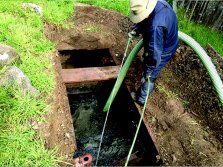Regular Maintenance of Septic Tank reduces the Cost of Operations by Up To 80 % And Increases the Life of a Tank by 15-20 Years
CleanAll Solutions provides you Septic Tank Maintenance Services using powerful Vacuum Suction Trucks to remove sludge from up to 25ft depth without anyone getting in direct contact with the sludge.
| Sr. No | Activity | Years after which activity is required | Total Cost | Cost/month | Cost/month |
| Years | $ | $/month | Rs/month | ||
| 1 | Installation of Septic Tank | 15 | 4000 | 22.22 | 2954.22 |
| 2 | Pumping of septic tank | 3 | 150 | 4.16 | 553.91 |
| Difference | 18.05 | 2400.30 |
Septic Tank collects sewage and wastewater separating it into different chambers. Septic tank is used where wastewater or sewage cannot be collected by mains or sewers. It usually consists of two compartments. Solids having higher density settle at the bottom whereas liquid waste passes to the other compartment. Solids get decomposed by anaerobic digestion and produce sludge. This sludge reduces the active volume of the septic tank and therefore there is a need to pump the tank.
Usually, the sludge from the septic tank needs to be pumped out every 1-3 years. If the number of people using the septic tank is more than its design population, then more frequent pumping will be required.
When any of the following is true or you spot any of these problems, schedule an emergency septic tank pumping right away:
To determine whether your tank needs pumping, you need to know how much scum and sludge are in the tank. Dip stick method is used. A tank with strong foul odors could be a sign of problems. Inspection involves the following steps:
Values provided in Section 2 can be used, otherwise, alternative values are also provided below:
If scum layer > 6 inches, pumping is needed
Sludge Layer> 12 inches deep, pumping required.
The depth of scum layer + Depth of sludge layer > 18 inches, pumping is required.
or
SC + SL > WD/3
Where,
SC=Thickness of Scum Layer
SL= Thickness of Sludge Layer
WD = Working Depth

Figure 2: Typical Septic Tank
A standard and conventional gravity system for a 3-bedroom house on a level site in good soil can vary greatly depending on where you live but it should be roughly between $1500 to $4000 (199,402 Rs to 531,740 Rs). Standard gravity fed, and trench systems typically only need to be pumped every 1-3 years. And will cost $ 75 to $ 150 (9970 Rs to 19940 Rs) if they need pumping. Average price for 2 bedrooms would be $125 to $ 250 (16616 Rs to 33233 Rs).
